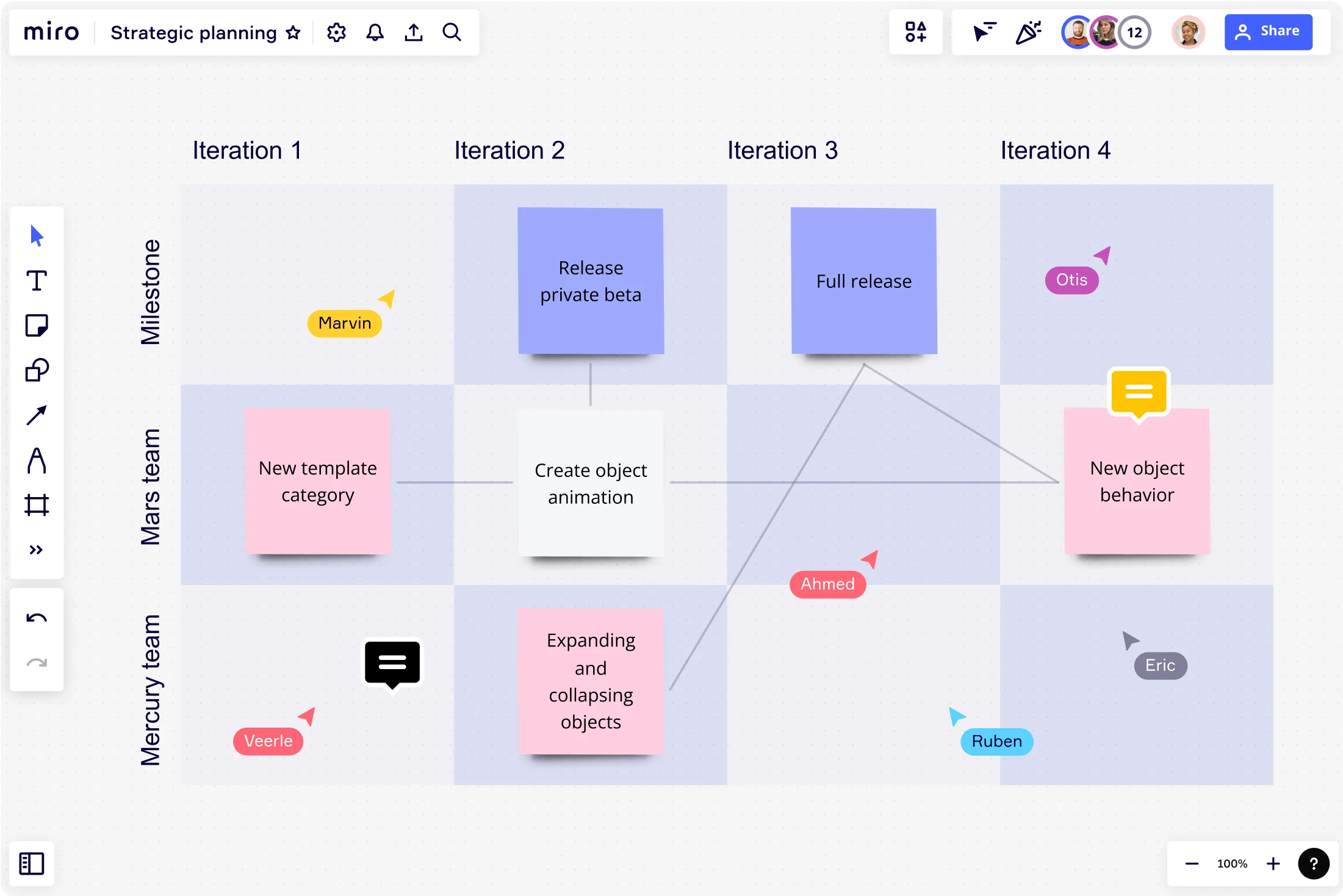
Table of contents
Table of contents
What is scenario planning?

Summary
In this guide, you will learn:
- What scenario planning is: a strategic tool to envision multiple plausible futures and their impacts on goals, operations, and strategies
- The benefits of scenario planning: improved decision-making, enhanced risk management, increased flexibility, and better preparedness for uncertainties
- How to use scenario planning templates in Miro to structure, customize, and collaborate on scenario exercises efficiently
- Key features of Miro’s scenario planning template: logical flow, flexibility, real-time team collaboration, and easy integration of artifacts like images and charts
- Differences between scenario planning and related approaches like forecasting and business continuity planning, highlighting its exploratory and long-term focus
- Practical tips for applying scenario planning in business contexts to anticipate market shifts, evaluate risks, and develop adaptable strategies
What is scenario planning: Your short guide to navigating uncertainty
Have you ever been in a situation where you wished you'd seen a business challenge coming from miles away? Well, that's why the best in the industry swear by scenario planning. This guide is your one-way ticket to becoming a future-ready business oracle. Let's delve into the nuances, shall we?
Where did scenario planning come from?
Scenario planning isn't a new-age concept—it's been around for decades. Originating in the military stratosphere during World War II, this method was all about strategizing optimal ways to approach enemy combat. The corporate world took notice, and Royal Dutch Shell was among the pioneers. They incorporated scenario planning to navigate the tumultuous oil market of the 1970s and emerged stronger. That's like turning foresight into a superpower.
Breaking down the term: What exactly is scenario planning?
So, let's dissect this term. Scenario planning is a systematic approach that equips you to handle potential future conditions. It's about envisioning various outcomes based on specific scenarios. Imagine it as a series of "What If" rehearsals for your business—a way to flex your strategic muscles to tackle opportunities or threats that the future may throw at you.
Why should you care: The benefits of scenario planning
Why invest your time and energy into this? First, it acts like a shield, reducing your vulnerability to market volatility and risks. Second, it synchronizes your entire team's decision-making process by providing a roadmap. Lastly, resource optimization—knowing where to put your money, time, and effort can yield incredible efficiency and ROI.
The Players: Who should be involved in scenario planning
It's a collective effort. While the C-suite heads the strategic direction, middle management offers invaluable ground insights. In fact, even rank-and-file employees should be roped in—they often have practical wisdom that might not be obvious from a bird's-eye view. So, think of it as an ensemble cast where everyone has a role to play.
When is the right time for scenario planning?
Contrary to popular belief, scenario planning isn't just for doomsday events. Proactivity beats reactivity. Make it a staple in your annual planning cycle. This ensures you're consistently assessing market dynamics rather than scrambling when crisis hits. Make it a calendar event, just like your annual audit.
Let's get technical: Types of scenario planning
Here's the nitty-gritty. Scenario planning can be qualitative, leveraging human insights and intuition, or quantitative, relying on numerical data and statistical models. You also have options to focus on explorative scenarios—those that answer 'What if X happens?'—or normative scenarios that help you forge a specific future by asking, 'How can we make X happen?'
Setting the stage: Elements to consider before you start
Preparation is half the battle won. First, gauge your existing business landscape. What's your market position? What are the broader economic conditions? Then, collect pertinent data. Are consumer habits shifting? What's happening in your supply chain? Finally, crystallize your objectives. What are you planning for? Expansion, consolidation, or perhaps, a venture into new markets?
Step-by-Step Guide: How to execute scenario planning
Ready to dive in? Here's the roadmap:
- Define Your Objectives: Is it risk mitigation, market expansion, or something else? Know what you're aiming for.
- Assemble Your Team: Pool together a multidisciplinary group, from finance to operations, to get a 360-degree perspective.
- Conduct Research: Here's where you scrutinize market trends, governmental policies, and competitor strategies.
- Develop Scenarios: Frame multiple scenarios based on variables like market demand, supply chain reliability, etc.
- Analyze and Plan: Weigh the pros and cons of each scenario and formulate actionable steps.
Making it stick: Documentation and sharing
Once you've wrapped up, don't let your hard work evaporate. Document your findings and action points meticulously. This document becomes your 'Business Bible,' referenced by all departments. Hold team briefings and disseminate the insights. Transparency with stakeholders could even enhance market trust.
Wait, what could go wrong? Common pitfalls to avoid
No process is foolproof. A common mistake is overcomplicating the scenarios—simplicity often yields the most actionable insights. Another pitfall is neglecting the emotional and cultural aspects—your team needs to believe in the scenarios to act on them. And remember, even the most brilliant plan is futile without implementation.
The Questions You Were Too Afraid to Ask
How long does it take? There's no one-size-fits-all answer. It can be a month-long intensive process or an ongoing effort.
Can small businesses benefit? Absolutely. In fact, smaller businesses often pivot more easily, making scenario planning even more impactful.
Any tools to recommend? Start with spreadsheets. But as you scale, specialized scenario planning software can be a game-changer.
The Future of scenario planning
With the advent of AI and machine learning, scenario planning is poised for a revolution. Real-time scenario modifications and machine-aided predictions will elevate this tool from valuable to indispensable.
By now, you should know what scenario planning is and appreciate its unparalleled value. In this ever-changing business landscape, scenario planning is your best bet for future-proofing your organization. So, why are you still here? Get to planning!
Author: Miro Team Last update: August 13, 2025